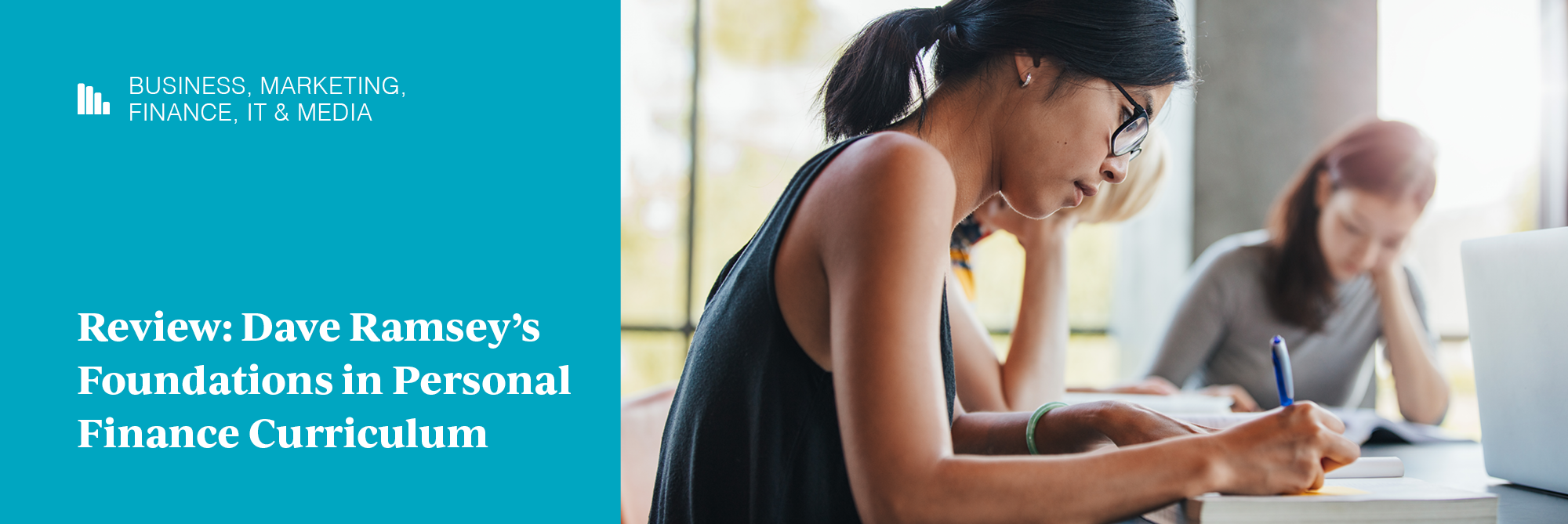Review: Dave Ramsey’s Foundations in Personal Finance Curriculum
After serving as a Texas FFA state officer in 2018, Josh Witherspoon joined the iCEV team as a part-time employee for 3 years before taking on the role of content development specialist in 2022. Witherspoon holds a bachelor's degree in agricultural communications from Texas Tech University, in which his experience and proficiency in writing, marketing and CTE allow him to effectively communicate the successes of CTE educators and students and the value iCEV has to offer.
Whether you’re a high school educator recently tasked with teaching personal finance or a veteran personal finance instructor, you want to make sure your curriculum is engaging, up-to-date and the best fit for your students. However, with all the options out there and factors to consider, choosing the right curriculum is a substantial challenge for teachers today.
As a passionate provider of personal finance curriculum and resources, teachers often ask us about the Dave Ramsey Foundations in Personal Finance resource, a popular curriculum choice for many classrooms.
In this article, you’ll explore an in-depth review of the Dave Ramsey Foundations in Personal Finance curriculum. Along the way, we’ll answer questions like:
- What Is the Foundations in Personal Finance Curriculum?
- What Topics Does This Curriculum Include?
- Who Is this Curriculum Intended For?
- What Are the Advantages of this Curriculum?
- What Are the Disadvantages of this Curriculum?
After reading this article, you’ll have a better understanding of what the Dave Ramsey curriculum offers and whether it’s the right fit for your students.
1. What Is the Foundations in Personal Finance Curriculum?
Ramsey Solutions is a curriculum provider established by financial advisor Dave Ramsey. They offer a variety of personal finance resources and curriculum including the Foundations in Personal Finance course.
This curriculum is designed to help educators prepare students to better manage their finances and build wealth so they can have a solid financial future. In addition, students explore valuable concepts including saving, investing, credit, debt and money management.
2. What Personal Finance Topics Does this Curriculum Include?
The Foundations in Personal Finance curriculum consists of 13 chapters:
- Introduction to Personal Finance
- Budgeting Basics
- Saving Money
- Credit and Debt
- Consumer Awareness
- Career Readiness
- College Planning
- Financial Services
- The Role of Insurance
- Income and Taxes
- Housing and Real Estate
- Investing and Retirement
- Global Economics
These in-depth chapters explore a wide range of financial topics to help students gain practical and relevant financial knowledge and skills for their futures.
Having the appropriate topics for your course is just the beginning when it comes to choosing the best curriculum for your students. The next factor to consider when making a decision is whether the curriculum will meet your students’ needs and your instructional goals.
3. Who Is this Curriculum Intended For?
The Dave Ramsey Foundations in Personal Finance course is designed for students in grades 9-12.
The course is a good choice for an educator looking for supplemental student coursework to implement alongside a more robust curriculum option. While this curriculum is in-depth, it isn’t comprehensive enough to teach a semester- or year-long course on its own.
On the other hand, if you’re looking for an all-in-one personal finance curriculum, this course may not be the best fit for your classroom. While the videos and textbook are full of valuable information, there’s not a wide variety of materials or opportunities for students to practice and apply what they’ve learned. To best meet the needs of every learner in your classroom it’s critical that you have many different materials and resources for them to engage with.
4. What Are the Advantages of This Curriculum?
Every curriculum option has unique advantages and disadvantages when it comes to how well it meets the needs of your classroom. In this section, you’ll discover the main advantages of implementing this curriculum.
Well-Organized
For a teacher in search of a structured curriculum that provides support for students as they learn and guidance for educators as they teach, the Foundations in Personal Finance course offers well-organized materials.
The curriculum uses a combination of videos, note-taking, and written activities to expose students to personal finance concepts and skills. It also includes ready-to-teach classroom activities and lesson plans that will help educators feel confident in what they’re teaching. In addition, educators will find pacing guides to help structure the curriculum to fit your course.
Well-organized curriculum makes it easier for teachers to spend less time planning for class and more time intentionally engaging students in their learning.
Price
The Foundations in Personal Finance course curriculum is priced per student. Currently, a subscription costs $49.99 for a subscription for a single student.
Additional student subscriptions will cost you $30 per student. For example, if you purchase 10 student subscriptions it will cost you around $320.
There are also bundling options available in which teachers can combine other curriculum resources offered by Ramsey Solutions to create a more comprehensive learning experience for your students.
If you’re an educator looking for an affordable supplemental resource that doesn’t require annual renewals, this could be a good option for your classroom.
Support
As a curriculum provider, Ramsey Solutions offers a wide variety of supporting resources for educators implementing the Foundations in Personal Finance curriculum.
For implementation and curriculum support, Ramsey Solutions offers resources including a Facilitator Guide. This Teacher Guide was constructed with lesson structure in mind. Each chapter is written in a way that allows teachers to arrange lessons with organization and creativity. Components include chapter commentary, differentiated instruction ideas, critical thinking exercises and discussion questions.
In addition Ramsey Solutions offers support and training through professional development webinars. These webinars are designed for teachers to learn about the curriculum, get prepared to teach the new Foundations in Personal Finance curriculum and leave feeling confident.
To learn more, contact Ramsey Solutions to find out when their next professional development webinar is to get a better idea of how they support educators implementing this curriculum option.
While knowing the advantages of a resource is beneficial in your search for the best curriculum for your students, knowing the disadvantages can help you make an even more informed decision.
5. What Are the Disadvantages of This Curriculum?
In this section, you’ll discover the main disadvantages of implementing the Foundations in Personal Finance curriculum.
Limited Materials
As stated earlier, the Foundations in Personal Finance curriculum is well structured and includes valuable information. However, where the resource falls short is in the amount and variety of materials and resources teachers have to keep students engaged.
Every module within the 13 chapters has the same materials including guided notes, two written activities, a case study and an assessment. With how repetitive these resources are, however, you may find your students feeling disengaged by them.
If you’re an educator looking for a curriculum resource with a wide variety of materials and resources to keep students engaged while learning personal financial literacy, the Foundations in Personal Finance curriculum may not be the best choice for your students.
Fully Digital Activities
When utilizing a fully digital curriculum, it is imperative to have some in-class activities or projects to keep students engaged in their learning. In-class activities bring concepts to life and help students better retain what they’ve learned.
However, Ramsey Solutions does not offer any in-class activities, as all of their assignments, and assessments are completed digitally. When using this curriculum, you will need to include additional resources to better engage your students.
Religious Components
This curriculum is considered secular, however; there are religious influences. While in some schools, having a religiously based curriculum is valuable, this isn’t the case in every school across the US. When deciding whether the Foundations in Personal Finance curriculum is a good fit for your classroom, think about what is allowable in your district and what is appropriate to share.
Is the Dave Ramsey Personal Finance Curriculum the Right Fit for your Students?
With all of the curriculum options out there, finding the best fit for your students can quickly become a challenge. From topics covered in the curriculum and intended audience to the advantages and disadvantages of the resource, there is a lot for you to consider.
This course is a good choice for an educator looking for supplemental student coursework to implement alongside a more robust curriculum option.
On the other hand, if you’re looking for an all-in-one personal finance curriculum, this course may not be the best fit for your classroom.
However, if you’re unsure that Foundations in Personal Finance is the best option, or if you just want to look into more options, it’s always a great idea to check out multiple providers to find the best fit for your students.
To that end, read this article comparing iCEV vs. Dave Ramsey for teaching personal finance. This article will help you determine which of these two resources is the better fit for your particular needs:


